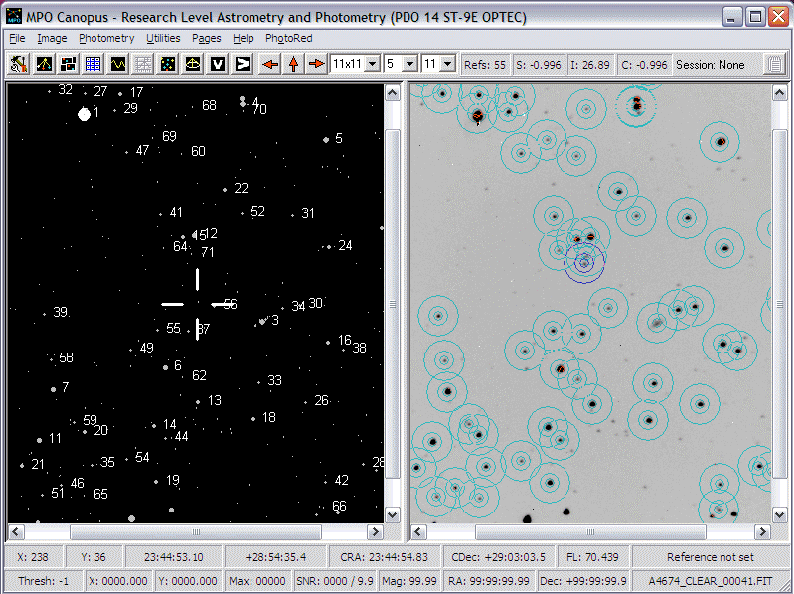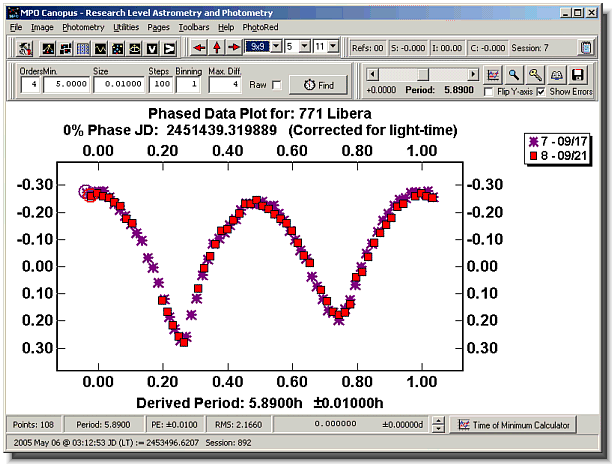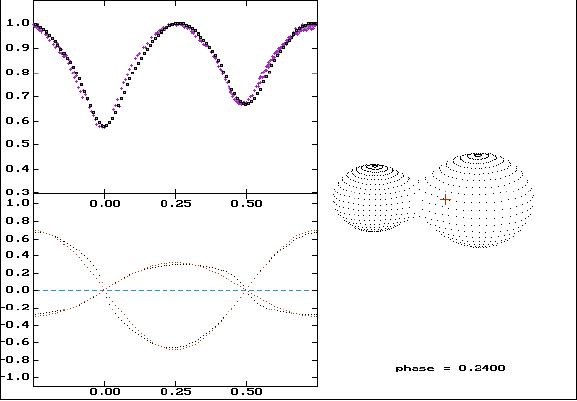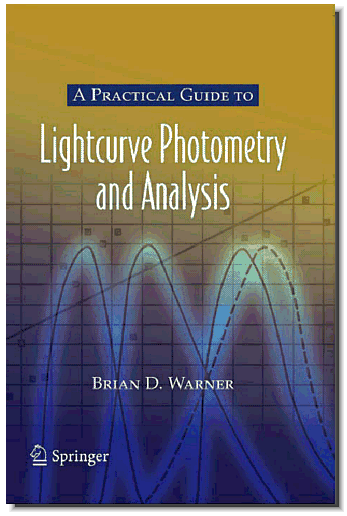 |
Announcement
Minor Planet Observer's Canopus Software
Special Edition now included for free with
photometric filter sets
and available for free to all new camera purchasers as of
June 1, 2006
 |
SBIG is proud to include a free version of Brian Warner's MPO Canopus software with every new Photometric filter set, and a coupon for a free copy of the software with every new camera beginning June 1, 2006.
MPO Canopus is one of the leading astrometry and photometry programs available for amateur use. With just one program you can process and measure your images, do photometric transforms, generate lightcurves, analyze periods and times of minimum, look for new asteroids or new variables, and much more. Special features built into Canopus make measuring images and analyzing lightcurve characteristics simple and easy. In just a few minutes, you can setup, measure 150-200 images, and start analyzing the lightcurve data. You can easily combine data from several nights and even different observers. MPO Canopus has been around since 1999, and has been used by amateurs around the world to submit thousands of astrometric positions to the Minor Planet Center.
Also since 1999, MPO Canopus has been used to measure images to determine the rotation period of hundreds of asteroids with many of the results appearing in journals such as the Minor Planet Bulletin and Icarus. In recent years, Canopus has also gained popularity for measuring and determining the lightcurves of variable stars. Canopus can even generate special files compatible with "Binary Maker", a popular binary star modeling program.
Canopus uses the "industry standard" Fourier analysis algorithm developed by Alan W. Harris for period analysis. While designed specifically for asteroid work, the routine in Canopus works very well on eclipsing binaries and other types of variables that have single periodic curves. Canopus has employed "ensemble photometry" from the beginning, allowing up to five comparison stars to be used to generate an average value subtracted from the measurement of the target object, be it an asteroid or variable star.
PhotoRed (PHOTOmetric REDuctions) is a utility program built into Canopus that allows you to covert the raw instrumental magnitudes measured in Canopus or PhotoRed to the Johnson-Cousins standard magnitude system. There's no need to use a spread sheet or other program in order to make the final calculations. PhotoRed determines the nightly extinction, transforms, and zero points using your images of standard fields. Once you have those values, you import the Canopus data into PhotoRed, convert the magnitudes to standard values, and export the data back for Canopus to use. PhotoRed includes provisions to convert Clear (unfiltered) observations to standard V, assuming you have at least some images in V of the target and a reference field. Higher accuracy can be achieved by having additional images in B or R.
Furthermore, both Canopus and PhotoRed produce plots of critical data so that you can easily eliminate obvious outliers or analyze the results with more certainty. What makes Canopus/PhotoRed stand out is that they are self-contained. You don't need to export your data to other programs to do calculations or do data analysis.
GENERAL FEATURES:
 |
PHOTOMETRY FEATURES (Canopus)
PHOTOMETRY FEATURES (PhotoRed)
 |
DEMO VERSION FEATURES
Some of the features in the registered version of MPO Canopus/PhotoRed are disabled in this special edition. However, all the features you'll need to measure images, find the period of a lightcurve, and reduce your data to standard magnitudes are fully available.
Only some of the "bonus" utilities that make Canopus/PhotoRed even more powerful research tools have been disabled. These include the Moving Object Search, Variable Star Search, and Double Star Measurements utilities along with some utilities that allow you to make backups of certain files.
Canopus uses the concept of "sessions" to work with data from different nights, filters, observers, etc. You are limited to 100 sessions in this special edition of the software. That should be more than enough to get you going. When you purchase a registered copy, your data will be preserved and so you can continue on without missing a step.
The Conversion utilities are also disabled. These allow you to update the MPCORB and ASTORB asteroid data files as well as the UserStar catalog where you can add custom stars used for photometry reductions. This is NOT a time-limited version of the software. You can use it indefinitely. However, you will not be able to get the free updates that are available to registered users.
 |
UPGRADE
Upgrade to the full version of MPO Canopus/PhotoRed by contacting MPO at: http://www.minorplanetobserver.com
Also recommended reading is Brian Warner's book: "A Practical Guide to Lightcurve Photometry and Analysis"
available at Amazon.com and BarnesNoble.com
SYSTEM REQUIREMENTS
MPO Canopus/PhotoRed Requirements:
PC Operating System: Windows 95 and above
Screen: 800x600x256 minimum, 1024x768x64K recommended (or higher)
Memory: That required to run O/S efficiently
Free Disk Space: About 1GB
Revised: June 02, 2006 02:08:10 PM.
Copyright © 2006 Santa Barbara Instrument Group, Inc. All rights reserved.
Please report any problems with this page directly to the Webmaster